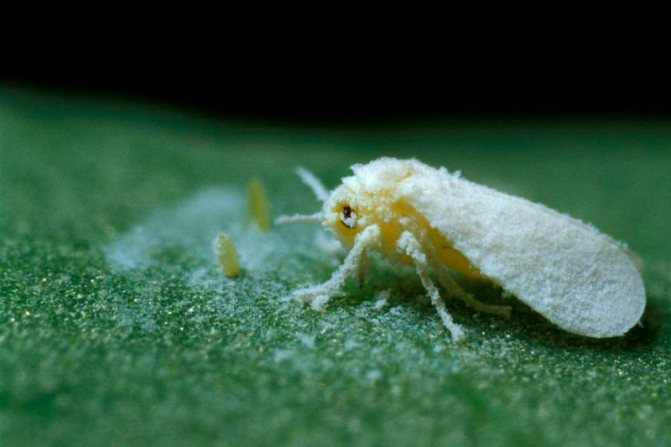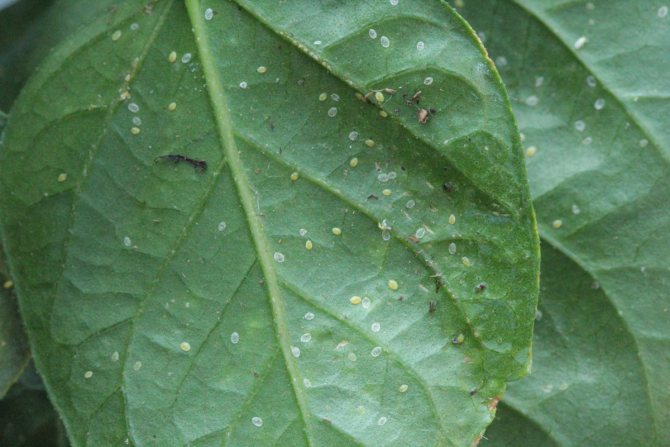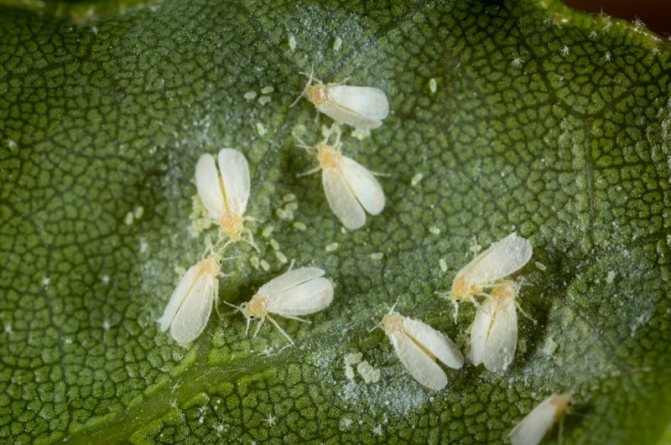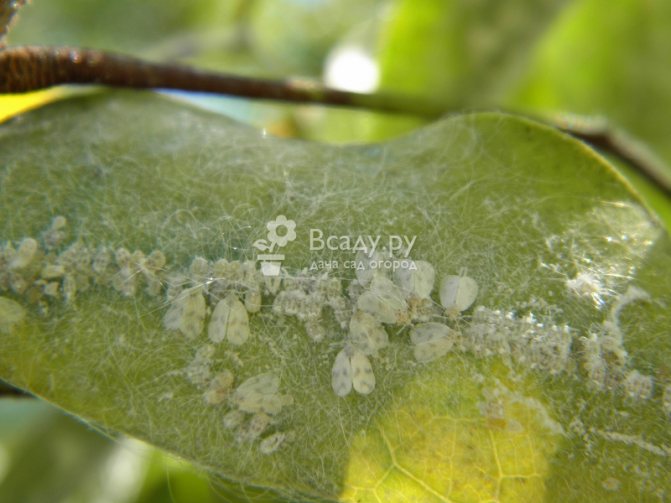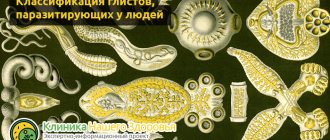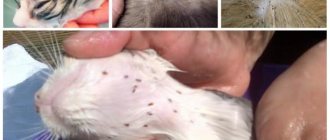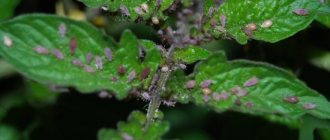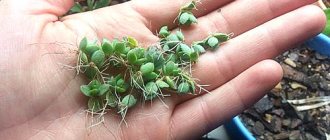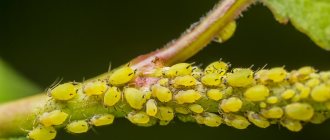Whitefly: what is this insect?
Whitefly, or aleurodida, is an almost invisible parasite that destroys garden and vegetable garden plants. The insect loves indoor flowers, tomato seedlings, peppers, cucumbers, eggplants. The parasite is especially common in greenhouse conditions. Individuals eat juicy foliage at all stages of life development. To get rid of a butterfly, you need to apply a whole range of preventive measures and use special means for treating summer cottages.
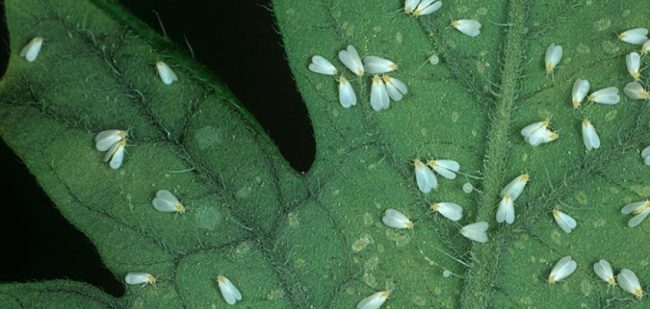
Varieties and classification of pests
There are about 1500 species of whiteflies in the world, which differ in habitat and food preferences. In greenhouse conditions, the parasite can constantly multiply, move, carry viral, fungal diseases. Eating the lower part of the stems, foliage leads to wilting of plants. Gradual damage to vegetable beds can significantly reduce yields.
Description of the main varieties of whiteflies found in temperate climates:
- Tobacco and cotton. The insect settles on various crops: turnips, beets, cabbage, indoor flowers, outdoor plants, tomatoes, potatoes.
- Greenhouse. Inhabits the soil of greenhouses and greenhouses, where the climate is always temperate. Found on indoor plants in warm apartments. This whitefly feeds on vegetables or ornamental crops.
- Citrus. It feeds on tangerine, lemon, orange or lime leaves. In Russia, it is found in greenhouses or in the south of the Crimea, the Caucasus.
- Cabbage. It settles on cabbage, namely, it eats the leaves of the crop at the end of August.
- Strawberry. Whitefly eats strawberry foliage, reduces yield, harms plant fruits.
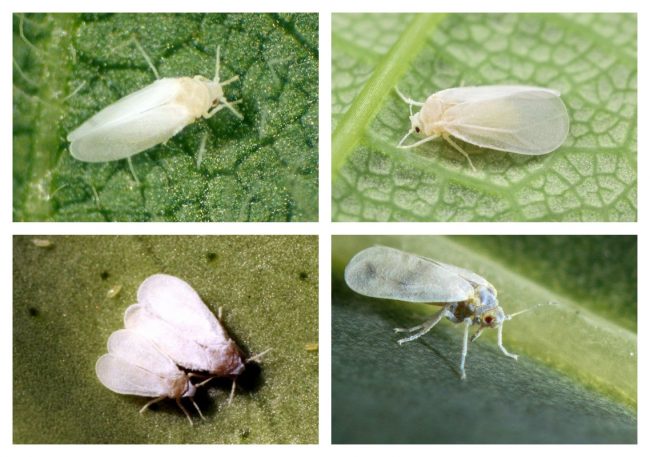

Cabbage and strawberry whitefly are not particularly dangerous for the garden and vegetable garden. The insect gives only one offspring for the entire season, and you can get rid of the invasion of butterflies by simply flushing the parasite with water. In apartments, aleurodids feed on fuchsia, begonia, orchid, geranium, balsam, passionflower or lantana. They can migrate to neighboring plants.
Habitat and suitable conditions for existence
Whiteflies love warmth and high humidity. Therefore, the parasite can develop year-round in greenhouses, while 3-4 generations are present in one area at once. In the garden or greenhouse, the parasite begins to appear en masse in July, when there is a strong heat (over 30 ° C). When the temperature drops below 10 ° C, adults and larvae die, but the eggs laid in the soil are able to winter.
It is interesting! You can meet the whitefly in home mini-greenhouses, which are organized on the windowsills. The insect infects seedlings, and then moves to indoor flowers.
Appearance
The whitefly looks like a small moth or white butterfly. The body length reaches 2-3 mm. The pest's wings are covered with a wax coating, which protects it from the effects of chemicals. The parasite larvae are located on the inner side of the leaf, on the lower stems of the culture. First instar worms have an oval shape, antennae, 6 legs. A couple of days after birth, the parasite settles in one place and looks like a microscopic whitish scale. When shaking the affected plant, a small cloud of small adults can be seen.
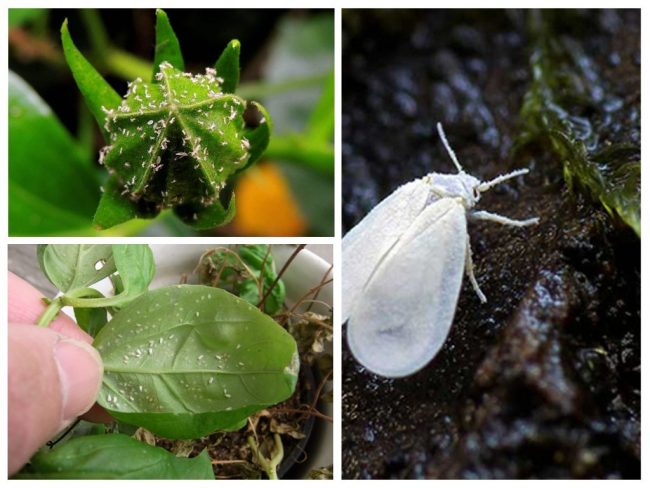

Whitefly life cycle
A female can mate up to 10 times in a month of her life. The life cycle of a parasitic butterfly includes many stages, which complicates the fight against the insect. The easiest way to get rid of the pest is in the period when the "vagrant" larvae appear, which become vulnerable in search of juicy leaves.
Whitefly maturation stages:
- an adult female lays eggs;
- after 14 days, whitefly larvae of the first instar appear from the clutch, which can search for a suitable habitat for a long time;
- larvae of the second instar stop at the most succulent areas and become covered with a waxy coating;
- larvae of 3-4 years old, or nymphs, eat well, but still do not have the ability to move.


The cycle ends after the adult (imago) begins to move to neighboring plants, beds. Mating of a female with a male occurs 12-20 hours after departure. It is best to kill the insect at this stage, before it has time to lay eggs. Larvae of the second instar do not lend themselves to mechanical treatment, they are resistant to chemical spraying.
Reproduction and distribution
One individual in just a month of life is able to lay up to 250 eggs or 15-20 eggs at a time. After 40 days, adult butterflies develop from the hatched whitefly larvae, which can migrate to other crops, move around the entire greenhouse or garden area with the help of the wind. The maximum number of the pest occurs in July-August, when hot and rainy weather prevails. With the onset of cold weather, the insect dies, but the eggs remain hibernating in the soil to begin their life cycle again in June.
What it looks like: description and photo
Pest
Whiteflies are omnivorous insects, but most species prefer to feed on the sap of a particular plant. Cabbage is attacked by the whitefly (celandine) whitefly.
An adult insect - slightly less than 2 mm in size - has white wings with 2 dark spots.
The body of a lemon-colored whitefly, with a dark pattern on the head and abdomen. The legs are long, the legs end with 2 claws.
Cabbage is destroyed by adults and larvae at all stages of development.
From the eggs laid by the adults, larvae appear, which at the first stage have legs and move freely through the plant, choosing the juiciest leaves. Larvae of stages 2-4 are motionless. At the 4th stage, a pupa (puparium) is formed, from which flying insects of both sexes appear. The cycle starts again.
Several generations develop during the season. In this case, adults and larvae of different stages can develop together.
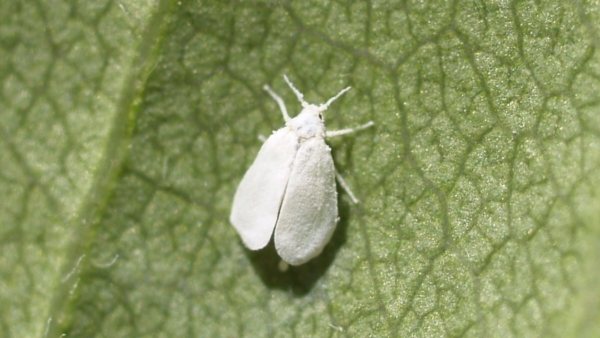

Affected culture
When a whitefly is affected, yellow spots appear on the upper side of the leaf plate. Also, dark spots appear throughout the sheet.
On sweet sticky secretions (insect waste) sooty fungi settle, interfering with photosynthesis. On a weakened plant, the leaves turn yellow and fall off. The cabbage is dying.


Signs of insects
At the initial stage, you can notice the infection of plants with a careful examination of the lower leaves and stems. If small white butterflies appear when shaking the bushes, the whitefly larvae have already caused serious damage to the plant. It is urgent to start fighting the insect using chemicals, remove infected leaves and bushes from the garden, and poison the soil.
The main symptoms that show the defeat of plants by the whitefly butterfly:
- the appearance on the back of the sheet of translucent scales;
- whitish sticky coating (honeydew) on the sheets;
- slowdown in plant growth, lack of fertility;
- the appearance of dark spots.
Traces of the whitefly, or honeydew, are produced by the larvae. These secretions are able to tighten the leaves of the plant, not giving it enough light and moisture.As a result, flower and vegetable crops begin to wither, the leaves curl, turn yellow, dry, and fall off. The sweetish bloom also attracts ants, which can settle in the greenhouse and bring aphids to the plant.
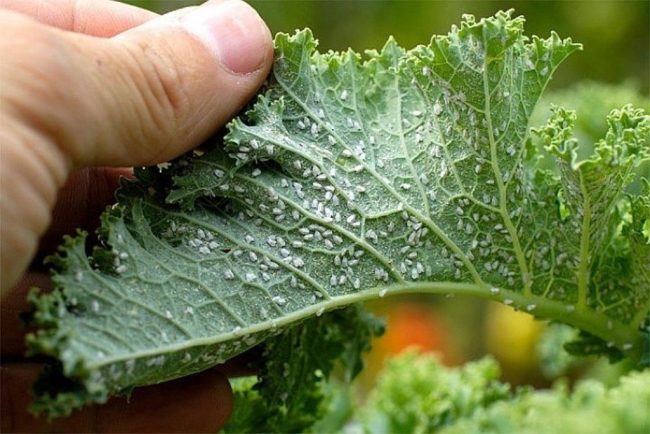

Meet the whitefly!
It's easy to recognize a whitefly. This is a small, slightly larger than aphids in size, a powdery white butterfly. The whitefly butterfly no longer spoils the cabbage, its life cycle ends, and it only lays eggs, of which there can be up to 300 eggs in one clutch! After a while, small, about 2-3 mm long, larvae hatch from the eggs.
The most dangerous for cabbage are voracious larvae, which simply destroy the juicy leaves. The food of the larvae includes the pulp and juice of cabbage. It affects the plant and the fungus that starts up in the white secretions left by butterflies. Black spores are clearly visible to the naked eye and such a plant can no longer be eaten. Some species of white-winged butterflies are pests of indoor plants, and it is not easy to get rid of whiteflies on indoor flowers.


Whitefly
The main causes of pest infection
To prevent crop diseases, you should know where the whitefly comes from in greenhouses and on indoor plants. The soil may contain eggs of the parasite. Therefore, when planting plants, it is necessary to carefully process the soil, even if it is purchased. The following conditions also provoke the appearance of butterflies:
- frequent watering of the plant;
- high humidity and temperature over 30 ° C in the greenhouse, rainy hot summer;
- close planting of crops to each other;
- lack of ventilation in greenhouses, greenhouses, apartments.
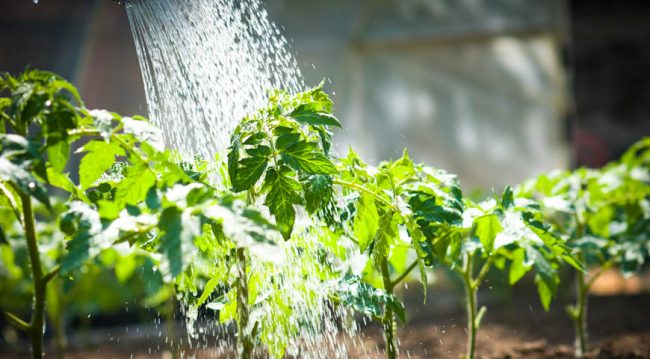

A pest can get into an apartment through open windows and doors. Therefore, it is recommended to regularly inspect the leaves of indoor plants, wipe them with disinfectants. Also, flowers should not be placed too close to each other.
Chemicals
But if, having lifted a cabbage leaf, you released a swarm of whiteflies from there, and the leaves themselves resemble green lace, it is necessary to use specially developed means. Here are some popular whitefly remedies that have been successfully used to water or spray cabbage:
- Aktara... A powerful remedy for midges and other pests, a real whitefly poison that can kill adults and larvae. It must be diluted with water and watered with cabbage. It is absorbed by the plant from the soil, gets into the juice and poisons it. Naturally, you cannot eat such cabbage for at least a month from the moment of processing. Suitable for fighting whitefly on tomatoes, cabbage and other crops.
- Aragventin... Another type of powerful poison that allows you to quickly get rid of the whitefly. It is used for spraying cabbage, but it must be done very carefully, it is especially good to process the places of accumulation of larvae or egg laying. The drug is able to stop their development.
- Golden spark... There are several varieties of this drug, so you can choose the form of its use that is convenient for yourself. Its biggest plus is its very low price and high efficiency. Alas, this is also poison and cabbage should not be eaten for 4 weeks.
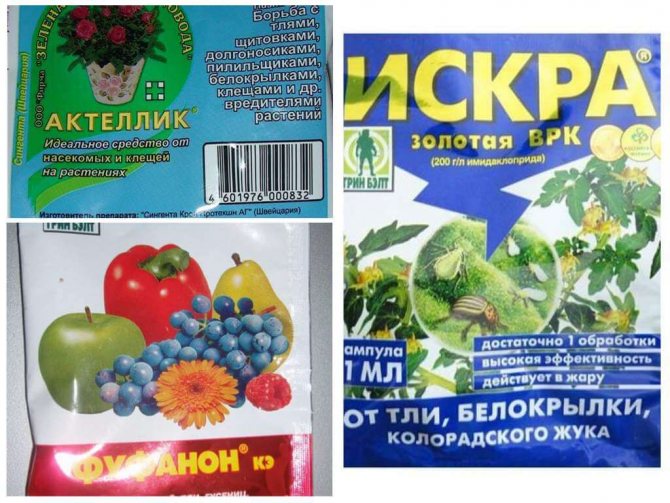

Preparations for whitefly on cabbage - Fufanon... A complex preparation that helps to get rid of whitefly and other harmful insects within a few hours. Only a few grams are diluted with water and cabbage leaves are abundantly sprayed with this solution. Do not allow the product to fall on the ground, since it remains in the soil for a long time and will poison cabbage and other plants.
- Actellic... A complex super effective preparation for protecting cabbage beds from almost all types of pests. Its big advantage is its fast disintegration and elimination period - only 14 days.But when processing, you need to be very careful and use personal protective equipment. If it comes into contact with the skin, it can cause burns, and into the lungs, severe allergies.
Important!
You need to be very careful with chemicals from garden pests. Most types of cabbage have the ability to adsorb them to the leaves and accumulate there. Therefore, if the recommended dosages are exceeded, the plant may become unsafe even for humans. This must be remembered before deciding what to water the cabbage from the whitefly, especially if it gets on the table for the child.
These are just a few of the most popular and effective drugs on the market, out of a lot more and better if an experienced gardener can help you make your choice. The scheme of application for each product is different, therefore, you must carefully study the instructions before use.
What harm is done?
The honeydew that the whitefly leaves on the leaves provokes the appearance of a sooty fungus. It clogs the pores of the plant, due to which the culture gradually dies from a lack of oxygen and the sun. Spores spread in the wind and remain in the soil. Therefore, a small butterfly can provoke crop death in the entire greenhouse. Infected plants are removed from the site and burned.
Whitefly is a carrier of the following diseases: leaf curl virus, golden mosaic, infectious yellowing of fruits and stems of crops. When the first symptoms appear, treatment is useless, it is urgent to get rid of the affected plants.
Description of the pest
India is considered the birthplace of the discussed insects. They prefer damp and warm places and affect not only cabbage, but also other vegetable crops, including plants from the melon family, as well as flowers.
Outwardly, the whitefly looks like a small moth, its body length ranges from 0.8–1.2 mm, and the larger individuals are females. The bodies of adults are light yellow, and the wings are always white, hence the name. There is a pair of antennae on the head.
The life span of a greenhouse pest is 30–35 days. Interestingly, the whitefly population is 75% female. Reproduction occurs rapidly - each female lays up to 130 eggs during her life.
Important! Whiteflies reproduce only at temperatures above 24 degrees and high humidity, which is why they are more common in greenhouses.
Eggs are laid on the underside of the leaves. Whiteflies spend most of their time there. After the completion of the stage of embryonic development, mobile larvae appear from the eggs, the size of their bodies does not exceed 0.3 mm. They need amino acids, so they immediately attach to the leaf of the plant and suck the juice from it.
After 10-14 days, the larva transforms and becomes like a scale with legs and antennae. Then comes the third stage of development, when whiteflies turn into nymphs. During this period, it is already possible to see the eyes on the insect's head. Its body changes color to light green and becomes covered with a waxy coating.
At the last stage, the size of the larva increases to 0.7 mm, wing buds are formed, and the legs become longer. The period of transformation into an adult with fully formed organs lasts about 12-14 days. The lifespan of a sexually mature individual is 2 weeks.
Means for dealing with the butterfly and its larvae
It is not easy to eliminate the pest from the beds, but with an integrated approach it will be possible to defeat several generations of whitefly at once. Chemical treatment of soil and plants from parasites should take place before planting seedlings and before the start of the vegetative stage. Folk recipes, mechanical methods and biological products are allowed to be used throughout the spring and summer season. In closed rooms, special fumigators handle the butterfly.
Glue traps
To combat adults, glue traps are used.When flying from plants or beds, most whiteflies fall into spaced traps. You can buy them at gardening stores, use regular sticky tape for flies. The trap can be independently made from cardboard or plastic greased with rosin, honey, petroleum jelly, entomological glue. Also, the parasite is attracted by the light from the light bulb, which burns their thin wings.
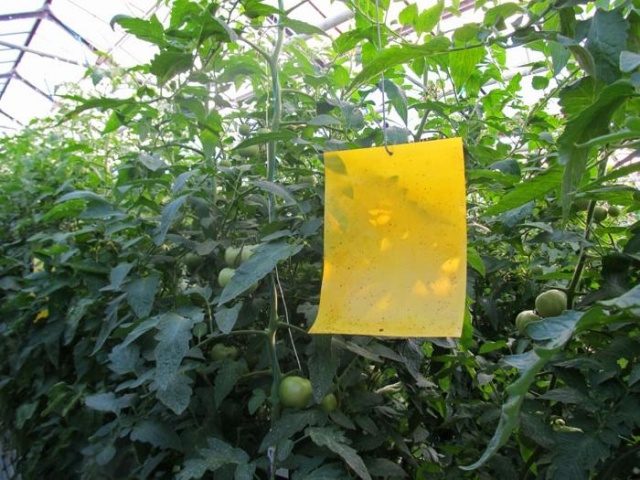

It is interesting! Homemade traps should be made on sheets, plywood, yellow or blue plastic. It is these shades that are attractive to the insect.
Chemicals
Chemicals help to get rid of the whitefly quickly and protect the plants for another 4-8 weeks. Insecticides get on the body of the insect and into the intestines (intestinal contact), provoke complete paralysis and death from exhaustion within 2-3 days. It is not recommended to treat vegetable crops with toxins after the onset of flowering and the appearance of ovaries. Also, chemicals can poison the population of beneficial insects: ladybirds, bees, wasps, lacewings.
Fitoverm
The safest insecticide that will remove the whitefly will not harm the health of humans, animals, and other beneficial insects. It is recommended to spray the soil, foliage, plant inflorescences. To exterminate all pests, 2 treatments with a break of 7 days are enough. The composition works for 3 weeks, becomes less effective after rains. The analogue of the means is "Match", "Appliance".


"Aktara"
A universal chemical preparation allows you to immediately poison whiteflies, aphids, midges, leaf beetles. The toxin from the soil is absorbed into the foliage and stems of plants, and it remains active for about 5 weeks. If it is necessary to kill large clusters of pests, a concentrated solution can be made. For this, a packet of "Aktara" is diluted in 3 liters of water, instead of 10 liters. From this dose, all butterflies and larvae will die, and the seedlings will not suffer.


"Spark"
"Golden Spark", "Spark - double effect", "Bio-Spark" are sold in the form of sticks, tablets, ampoules, which are used according to the instructions. The chemical will save the crop from whiteflies and aphids after just one spray. An irrigated bush contains toxins for up to 30 days, during which time the entire pest population dies.


Do not re-treat plants with the same preparation. The insect will be able to adapt to the toxic composition.
Folk recipes
The fight against whitefly at home begins with the use of folk methods. Recipes based on herbal decoctions, infusions, household chemicals, improvised means can get rid of many pests. The natural composition of solutions for spraying beds does not accumulate in the soil, contributes to better yields, does not harm beneficial insects, and does not burn seedlings.
Soapy water
The soap solution washes away the protective wax film from the insect, paralyzes it, provokes death within 2-3 days. To prepare the product, you need to take a bar of laundry or tar soap, grate and dilute with 6-7 liters of water. You can spray the bushes with a spray bottle or manually rinse each leaf with a foam sponge.
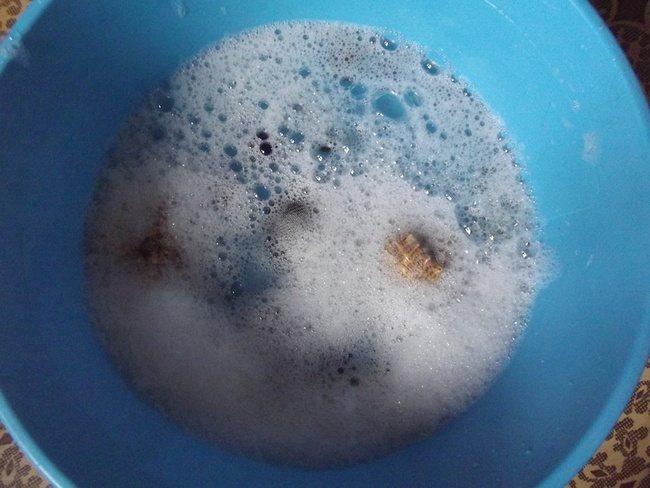

Garlic infusion
Indoor plants are treated with tincture. For its preparation, it is enough to pour 2 chopped garlic cloves with boiling water, send to a dark and cool place for a day. After insisting, the agent is filtered, poured into a spray bottle. To kill the entire whitefly population, treatments are carried out every week for a month.
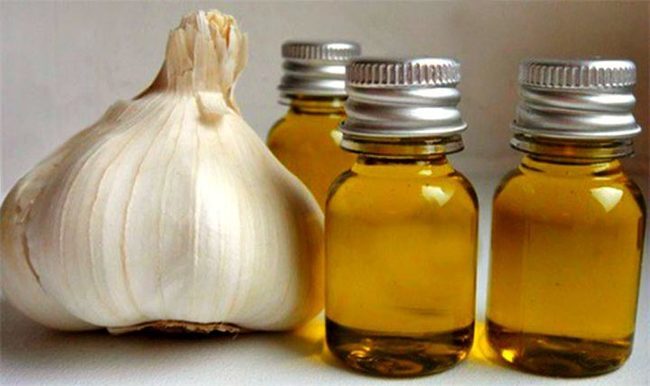

Infusion of Yarrow Herb
You can get rid of whitefly with the help of yarrow juice. To prepare the infusion, take several bushes, chop it finely, knead it with your hands, pour 4 liters of boiling water. The remedy is infused for 2 days, after which it is filtered and diluted with another 4 liters of water.For better adhesion of the composition, it is recommended to add about 30-40 ml of liquid soap or shampoo before treating the garden. The medicinal plant can be replaced with celandine.


Infusion of tobacco
Small whitefly clumps can be dealt with with tobacco. You need to purchase 1 pack of cheap cigarettes, get the contents out of them, pour 1 liter of boiling water. For infusion, the mixture is sent to a dark and cool place for 5 days. After the strained agent, the affected plants are sprayed every 3 days.


Dandelion decoction
To prepare the product, take juicy dandelion bushes (along with the roots), chop finely, pour 1 liter of boiling water, and then the mixture is kept on low heat for 15 minutes. To make a tincture, the herbal decoction is sent to a dark place for 4 days. If it is necessary to process greenhouses, greenhouses or garden beds, the portion volumes are increased by 10 times.


Ammonia
The pungent smell of ammonia repels small pests, fertilizes the soil, and helps to enhance the growth and flowering of indoor plants. 2 tbsp is enough for a bucket of water. l. ammonia, 30 ml of liquid soap. Processing is carried out after 18.00 or in cloudy weather, so as not to burn tender leaves of seedlings under the scorching sun.
On a note! You can replace ammonia with vinegar. Its smell is also harmful to insects.
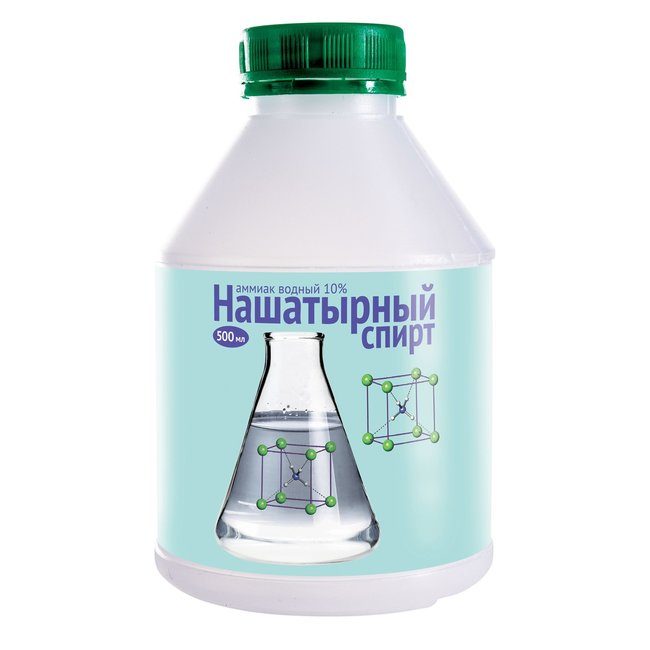

Ash
Wood ash helps to save the beds from whiteflies, fleas, and aphids. Sprinkle it on the soil under the plants, process the aisle or irrigate the deciduous part with a solution. You need 1 tbsp. pour ash 5 liters of water, simmer for about 15 minutes. After the broth is cooled and the beds are irrigated with a broom.


Sugar tincture
Sugar infusion is suitable for preventing the appearance of whitefly on plants. Plants that were in the same greenhouse or nearby with affected crops are treated with a safe agent. To prepare the solution, take 200 g of sugar, 1 liter of warm water, mix the ingredients and spray the leaves.


In order for the plant to receive a sufficient amount of oxygen and light, after 5-6 days after treatment, the sugar solution must be washed off the leaves.
Mechanical methods
Fight whitefly in small areas by hand. It is enough to inspect each leaf of the plant from the inside several times a week. When larvae and butterflies are found, they are shaken off, killed, washed off with soapy water. It is also recommended to regularly water with a hose in order to dump pests to the ground under pressure.
Biological measures
Biological insecticides work in the same way as chemical preparations, but have a more natural, safer formulation. Processing can be carried out after the formation of ovaries, does not make the fruit toxic, fumes do not harm humans and animals. The most effective remedy "Verticillin Zh" contains spores of a fungus that is dangerous for insects. After the poisons enter the intestines, the whitefly begins to hurt, infects other individuals and dies after 8-10 days.
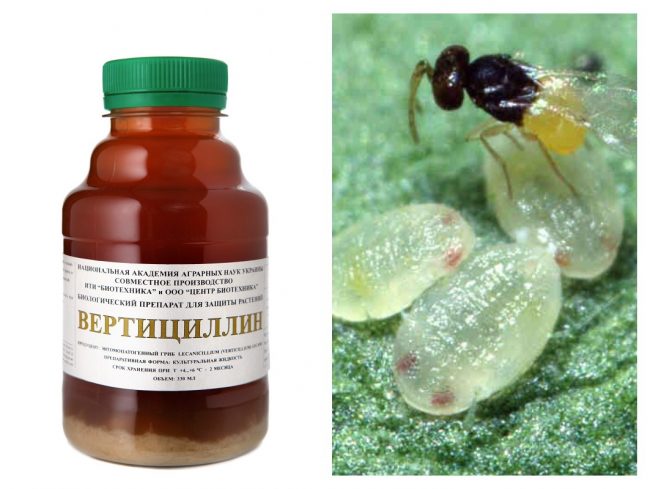

Biological measures also include the addition of beneficial insects to the beds that feed on the whitefly. Encrasia is a parasite parasite that lays its eggs in butterflies. It can also suck juice from immobile larvae. Ladybugs and macrolofus bugs love to eat the parasite. To attract predators, dill, marigolds, daisies are planted around the perimeter of the site.
Fumigators
In greenhouses, conservatories and apartments, you can use a mosquito and fly fumigator. They are placed around the perimeter at the same distance from each other, windows and doors are closed. During the operation of the device, you must leave the room, pick up your pets. Poisonous fumes are effective for butterflies and larvae, but not terrible for eggs. Therefore, after a few weeks, the procedure is repeated.
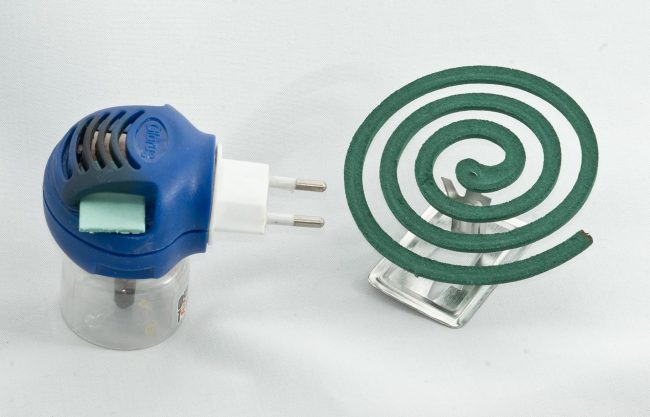

Whitefly on tomatoes: control measures, folk remedies
Tomatoes are more likely to be affected by whiteflies than other crops.The fight against the pest is complicated by the fact that insects can simultaneously be present on the plant in three phases of development at once - eggs, larvae, butterflies.
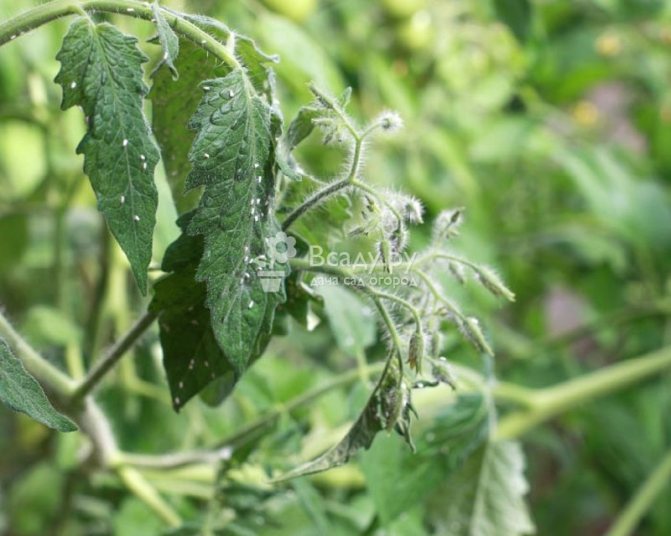

Whitefly on tomatoes leads to gradual wilting of the bush
The following signs indicate the appearance of parasites:
- sticky whitish bloom on the leaves;
- curling and yellowing of leaves;
- the formation of necrotic spots;
- detection of larvae by visual inspection.
Disinfection of the greenhouse and soil
The insect can appear both in the open field and in the greenhouse. Infection of greenhouses treated with disinfectants is possible through purchased soil, seedlings. To treat greenhouses after infection with whitefly, Ecocid C is used, fumigation with sulfur sticks, the inner surface is washed with a solution of lime or 1% iron sulfate.
For prophylaxis, imported soil for greenhouses, or for leveling the surface of the site, is treated with fungicides Alirin B, Baikal-EM1.
Beneficial insects
The fight against whitefly on tomatoes can be carried out entirely by biological methods, involving the cultivation of beneficial insects in greenhouse conditions that destroy the pest.
This group includes ladybugs, lacewings, macrolofuses. This method is completely safe for plants and the environment, but is effective only with primary signs of damage.
The encarsia parasite (lat. Encarsia partenopea) helps to completely destroy the whiteflies, which destroys the caterpillars before they have time to turn into pupae. Up to 10 individuals are populated per square meter, but this must be done before planting the plants.
Application of encarsia to protect against whitefly
For the settlement of ethnomophages (parasites that destroy insects harmful to the garden), special cages are used. They are hung by string or wire throughout the greenhouse. A prerequisite is shade, or protection from direct sunlight. For encarzia pupae, a moistened cotton swab is placed on the bottom of the garden to protect them from drying out and to increase the population.
The approximate cost of five hundred individuals of Encarsia is 300 rubles. You can buy it in specialized shops for gardening, it is recommended to place it in a greenhouse within 24 hours. The fight against whitefly on cucumbers with the help of beneficial insects is not effective because of the hairs on the leaves, in which the larvae of the pest hide.
Folk ways
- spraying tomatoes with yarrow infusion (100 grams per 1 liter of hot water);
- the use of tincture of dandelion roots (80 grams of plant roots per 1 liter of boiling water)
- using garlic tincture diluted with water.
If the situation is neglected and the whitefly has managed to noticeably harm the plants, it makes sense to use special chemicals. You can use the same as for processing cucumbers and cabbage. In greenhouses, treatment with Vertimek, Fitoverm, Pegasus is recommended.
Terms and rules for processing plants
Processing should be carried out at least 3 times per season. The first time the soil is irrigated with chemicals in May-June, then a few weeks after planting the seedlings, the procedure is repeated. The last sprinkling will be in July. If large accumulations of pests are noticed in the country, you need to immediately start treating plants with the help of folk methods. Soap solutions and herbal decoctions can be used every week until the whitefly disappears completely.
Treatment of plants with chemicals should take place in an open area or in a ventilated area. Gloves, tight clothing, and a respirator are worn for protection After spraying poisons, you cannot work on the beds for several days, since an invisible poisonous cloud still remains above them. After the formation of ovaries, chemical preparations are contraindicated. The crop is harvested no earlier than a few months after the plants are irrigated with toxins.
Treatment of plants from whitefly should take place in calm, cloudy weather.If, after spraying with natural products, it rains, the procedure is repeated again. 30-40 ml of liquid soap is added to any solution, which ensures better adhesion of the composition to the leaves.
Hibiscus leaf diseases
The photos presented on the page clearly demonstrate the effect of diseases on the leaf plate of a plant.
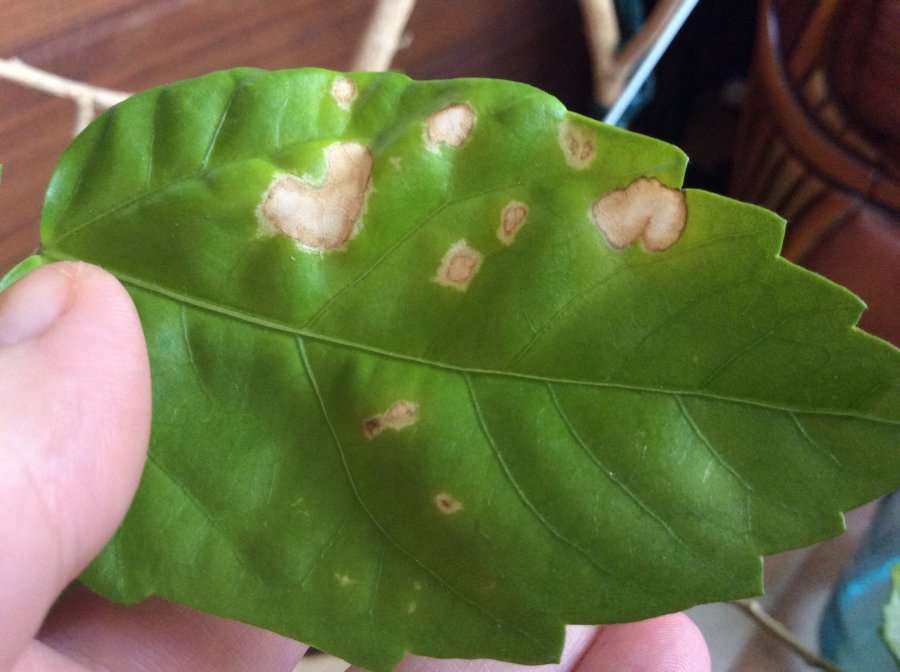

Basically, leaf changes provoke chlorosis. When it occurs, the amount of chlorophyll produced is reduced. Consider common symptoms and their causes:
- Yellowing of the leaf plate. It occurs due to the fault of pests, the presence of diseases of the root system (including decay), chlorosis, dry air inside the room (often when central heating is turned on or heaters are used).
- Dropping greens. The reason is insufficient humidity, lack of spraying in the heat, dramatic changes in lighting, and the presence of drafts. Other stresses can also have a negative impact, such as transplanting, heavy pruning, etc.
- Curling foliage into a tube. It occurs due to the appearance of pests that suck the juice.
- Withering leaves. Wanting to figure out what to do when the leaves of a hibiscus wither, you need to pay attention to the temperature and humidity of the air. The symptom manifests itself in extreme heat and with a decrease in humidity.
- Withering of the tip of the leaf plate. It will require the introduction of nutrients into the soil. Such a nuisance can be caused by a lack of nitrogen, phosphorus and other mineral elements.
- Falling buds and foliage. The problem arises when there is a lack of potassium, the plant is damaged by gall midge, or a high room temperature.
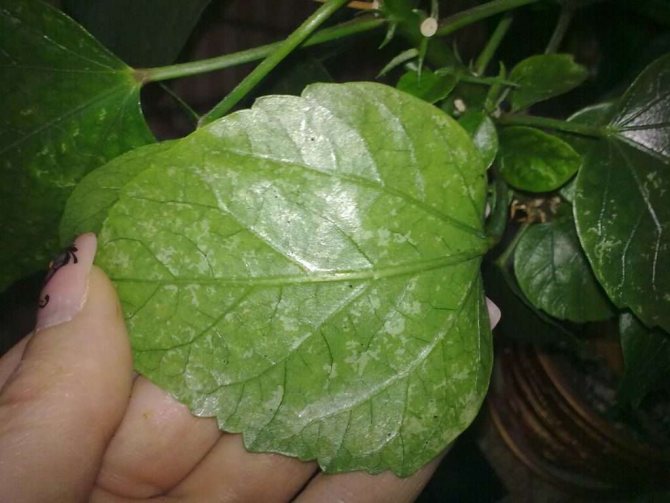

Prevention of re-infection
To prevent the appearance of whiteflies on the site, after harvesting, deep digging of the soil is necessary. Weeds are removed from the beds, disinfection is done. For owners of greenhouses and greenhouses, it is recommended to freeze the premises, regularly smoke it with checkers. In the spring, you should protect seedlings from butterflies with nets, hats, caps.
It is not worth treating the soil with chemicals for the winter. At temperatures below + 9 ° C, the whitefly and its larvae die on their own. Eggs are not affected by cold and toxins.
To prevent small flies from growing in indoor plants, it is necessary to carefully inspect the purchased soil. You cannot completely force the window sills with flowers. The room is regularly ventilated, the trays are cleaned of accumulated moisture, each leaf is examined for the presence of larvae. When the first signs of infection appear, the plant is sent to quarantine.
The whitefly is not able to completely destroy the crop, but it can provoke the development of many diseases dangerous to plants. Therefore, gardeners and gardeners carry out preventive measures, processing plantings from pests, closely monitor the condition of greenhouses and greenhouses. To combat the parasite, it is enough to comprehensively use chemicals, folk remedies, special traps and fumigators.
Gardener Tips
During the active development of butterflies and other flying insects, it is recommended to protect windows and entrances to the greenhouse with gauze. Mosquito nets can work well. They protect cabbage plantings in greenhouses from the abundance of flying parasites, while the windows can be open and reduce excess moisture.
Important! You can actively fight the whitefly with an ordinary fumigator and fly tape.
Experienced farmers have long noticed that insects of this species are very fond of orange. By installing a small shield next to the cabbage beds, and smearing it with something sticky, you can get an impromptu trap. Insects will stick to its surface and die.
Ornamental Plants Attacked by Whitefly
- Ash, oak, chestnut, etc.decorative, fruit and citrus trees
- Cotton and melons
- Irises
- Gladioli
- Hibiscus
- Begonias
- Lilac, gardenia, privet, jasmine and other fruit and ornamental shrubs
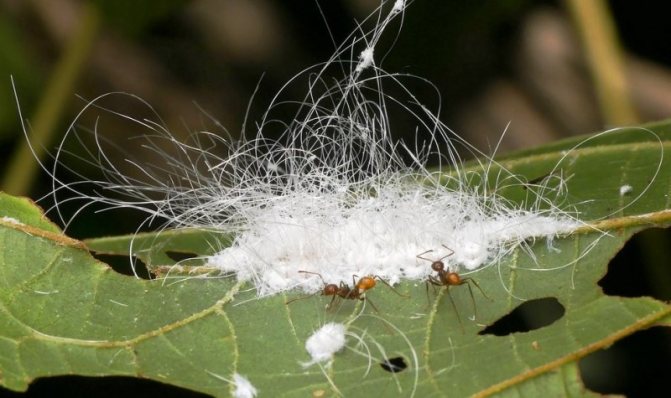

Whitefly and ants.
As you can see, the whitefly is almost omnivorous and attacks not only vegetable crops, but also decorative and indoor plants.
Why is a leaf-eating flea dangerous?
The cabbage leaf is permanently damaged
- Mandatory deep autumn digging of the soil. Everything is clear here - the bugs that have settled down for the winter will be turned up on the surface and will die with the onset of the low-temperature regime.
- Early spring is a period of rapid development of weeds. They should not be in the garden and around the perimeter of the site. Particular attention to the weed of the cruciferous family - beetroot, wild radish, shepherd's purse, sverbig, etc.
- At the final stages of the growing season, weed removal should be carried out in such a way that as little loose seeds as possible fall into the soil.
- It is better to sow cabbage of early varieties under a film. For planting seedlings, you must choose cloudy weather. Since the flea loves warmth and heat, then at high humidity it will not attack plants, which means that the period of adaptation to open ground in cabbage will be more or less calm.
- It is better to mulch the surface of the soil with mowed grass, unnecessary and therefore plucked from the tomatoes by stepchildren. Also, you can spread tansy twigs - fleas do not like this smell.
- In hot weather, nurseries or plants already planted in open ground must be protected with a transparent breathable nonwoven fabric. It can be spandbod, lutrasil, etc. Ash or ground red pepper is scattered along the edges of the cloth.
- Shown is small-drop watering with cool water, to which garlic infusion or infusion of medicinal dandelion, green wormwood is added.
- Plants need to be fed in a timely manner - this accelerates their growth, makes them strong and resilient. In this state, they will be able to more firmly endure damage from a flea. And coarse large leaves are less attractive to an insect.
Mechanical methods
- Scare away. A canvas smeared with a sticky substance is attached to the stick. It can be honey, grease, long-drying glue. This "flag" should be drawn along the rows of cabbage through the leaves. Frightened insects take off and jump, and as a result they stick to the trap. In a short time, a lot of flea beetles will stick to the canvas. They are cleaned off, the material is again covered with a sticky substance and the procedure is continued. You can use cardboard or plywood instead of canvas.
- Traps can be made individually for infected plants. A cone-shaped cap is twisted from paper, the dimensions of which would make it possible to put on seedlings without damaging it. The inner surface of this design is also covered with a sticky compound. When installing the cap, the plant needs to be slightly touched so that the fleas stick where they need to.
- If black fleas eat cabbage, then between the rows you can place flat containers filled with water mixed with kerosene. Periodically luring composition must be replaced.
Watered cabbage with cold water
Chemicals
Broad-spectrum drug
- "Actellik" is an organophosphate insectoacaricide of a non-systemic type, which has an enteric action. Supplied in the form of an emulsion concentrate. Spraying is indicated during the growing season. Double processing is allowed at intervals - after 20 days.
- "Intavir" is a drug of the pyrethroid group. It goes on sale in the form of powder or tablets. In special neglected cases, spraying with a solution is allowed three times every 2 weeks.
- "Decis" is a complex preparation that acts on a pest in a contact-intestinal way. After entering the body, it blocks the nervous system, blocking the path of its nutrition. Further paralysis and death. The product is low-toxic, safe for humans.
- "Bankol" is a white crystalline powder. Amine derivative agent. It is moderately toxic. Recommended during the growing season. Does not accumulate in plants - already 7 days after treatment it is not detected in tissues. The active protection period is 15 days.
- Aktaru is a modern broad spectrum insecticide. It can be used both for soil application and for spraying. The consumer can choose between water dispersible granules (WDG) and suspension concentrate.
In conclusion, we want to note that some gardeners argue that an effective remedy for such insects is a dog flea shampoo. For our part, we do not recommend using it.
Check out articles on similar topics
- Tips on how to get rid of cabbage moth
- We save cabbage from a bear
- Getting rid of the cabbage stem lurker
- Fighting the cabbage flea
"To plant cabbage without opening your mouth to walk." This Russian proverb suggests that the cultivation of familiar cabbage has its own subtleties and secrets. In addition to the peculiarities of planting, one must be ready to protect the seedlings from bad weather and disease.
Cabbage, or cruciferous, or black flea is an earthen flea belonging to the leaf beetle. A very small insect, about 3 mm in size, is widespread in Russia, Europe, Asia. The color of the bugs is different depending on the species:
- the black;
- grey;
- blue;
- green.
The adult booger eats the leaves, and the larvae eat the thin roots of plants.
Gardeners have long understood how to treat cabbage from fleas in order to save the crop. As with any disease, many methods of struggle are used against this scourge.



